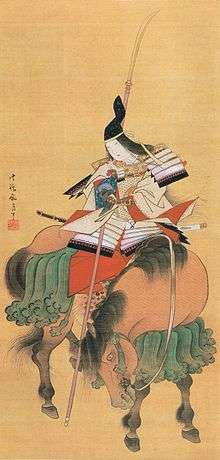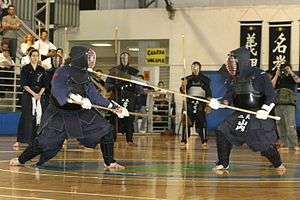Naginata
The naginata (なぎなた, 薙刀) is a pole weapon and one of several varieties of traditionally made Japanese blades (nihonto).[1][2] Naginata were originally used by the samurai class of feudal Japan, as well as by ashigaru (foot soldiers) and sōhei (warrior monks).[3] The naginata is the iconic weapon of the onna-bugeisha, a type of female warrior belonging to the Japanese nobility.

Naginata for fighting men and warrior monks were ō-naginata. The kind used by women was called ko-naginata. Since the naginata with its pole is heavier and much slower than the Japanese sword, the blade of the ko-naginata was smaller than the male warrior's ō-naginata in order to compensate for the lesser height and upper body strength of a woman than an armoured male samurai.
Description
A naginata consists of a wooden or metal pole with a curved single-edged blade on the end; it is similar to the Chinese guan dao[4] or the European glaive.[5] Similar to the katana, naginata often have a round handguard (tsuba) between the blade and shaft, when mounted in a koshirae. The 30 cm to 60 cm long naginata blade is forged in the same manner as traditional Japanese swords. The blade has a long tang (nakago) which is inserted in the shaft.
The blade is removable and is secured by means of a wooden peg called mekugi that passes through a hole (mekugi-ana) in both the tang and the shaft. The shaft ranges from 120 cm to 240 cm in length and is oval shaped. The area of the shaft where the tang sits is the tachiuchi or tachiuke. The tachiuchi/tachiuke would be reinforced with metal rings (naginata dogane or semegane), and/or metal sleeves (sakawa) and wrapped with cord (san-dan maki). The end of the shaft has a heavy metal end cap (ishizuki or hirumaki). When not in use the blade would be covered with a wooden sheath.[3]
History
The naginata was developed from an earlier weapon type of the later 1st millennium AD, the hoko yari.[6][7] It's difficult to tell when the naginata itself first appeared. Though often claimed as being invented by the sōhei during the Nara period, physical evidence of their existence dates only from the mid-Kamakura period, and earlier literary sources are ambiguous. The earliest clear references to naginata date from 1146 in the late Heian period, with one suggesting that the weapon may have been recent.[8] Earlier 10th through 12th century sources refer to "long swords" that while a common medieval term or orthography for naginata, could also simply be referring to conventional swords; one source describes a naginata being drawn with the verb nuku, commonly associated with swords, rather than hazusu, the verb otherwise used in medieval texts for unsheathing naginata.

Some 11th and 12th century mentions of hoko may actually have been referring to naginata.[9] The commonly assumed association of the naginata and the sōhei is also unclear. Artwork from the late-13th and 14th centuries depict the sōhei with naginata but don't appear to place any special significance to it: the weapons appear as just one of a number of others carried by the monks, and are used by samurai and commoners as well.[10] Depictions of naginata-armed sōhei in earlier periods were created centuries after the fact, and are likely using the naginata as a symbol to distinguish the sōhei from other warriors, rather than giving an accurate portrayal of the events.[11]
During the Genpei War (1180–1185), in which the Taira clan was pitted against the Minamoto clan, the naginata rose to a position of particularly high esteem, being regarded as an extremely effective weapon by warriors.[12] Cavalry battles had become more important by this time, and the naginata proved excellent at dismounting cavalry and disabling riders. The widespread adoption of the naginata as a battlefield weapon forced the introduction of greaves as a part of Japanese armor. The rise of importance for the naginata can be seen as being mirrored by the European pike, another long pole weapon employed against cavalry. The introduction in 1543 of firearms in the form of the matchlock (tanegashima) caused a great decrease in the appearance of the naginata on the battlefield. As battlefield tactics changed, the yari (spear) took the place of the naginata as the pole weapon of choice.
.jpg)
In the peaceful Edo Period, weapons' value as battlefield weapons became diminished and their value for martial arts and self-defense rose. The naginata was accepted as a status symbol and self-defense weapon for women of nobility, resulting in the image that "the Naginata is the main weapon used by women". A naginata was commonly a dowry of women of the nobility. But historical recordings describing the practice of martial arts by women are rare and uncertain.
In the Meiji era, it gained popularity along sword martial arts. From the Taisho era to the post-War era, the naginata became popular as a martial art for women, mainly due to the influence of government policies. Due to this influence, the image that “spears are women's weapons” was formed.
Although associated with considerably smaller numbers of practitioners, a number of "koryu bujutsu" systems (traditional martial arts) which include older and more combative forms of naginatajutsu remain existent, including Suio Ryu, Araki Ryu, Tendo Ryu, Jikishinkage ryu, Higo Koryu, Tenshin Shoden Katori Shinto Ryu,Toda-ha Buko Ryu and Yoshin ryu, some of which have authorized representatives outside Japan.
In the USA, there are an estimated 200 practitioners.[13]
Contemporary construction
In contemporary naginatajutsu, two types of practice naginata are in common use.
The naginata used in atarashii naginata, the shiai-yo, has an oak shaft and a bamboo "blade" (habu). It is used for practice, forms competitions, and sparring. It is between 210 cm and 225 cm in length and must weigh over 650 grams.[14] The "blade" is replaceable. They are often broken or damaged during sparring and can be quickly replaced, being attached to the shaft with tape.
The naginata used by koryū practitioners has an oak shaft and blade, carved from a single piece of wood, and may incorporate a disc-shaped guard (Tsuba). It is called a kihon-yo.
Many of the "realistic naginata" for sale to the public are not naginata at all. These imitations have shorter, rounded shafts, very short blades, and screw-together sections.
Contemporary usage

Naginata can be used to batter, stab, or hook an opponent,[15] but due to their relatively balanced center of mass, are often spun and turned to proscribe a large radius of reach. The curved blade provides a long cutting surface without increasing the overall length of the weapon.
Historically, the naginata was often used by foot soldiers to create space on the battlefield. They have several situational advantages over a sword. Their reach is longer, allowing the wielder to keep out of the reach of opponents. The weight of the weapon gave power to strikes and cuts, even though the weight of the weapon is usually thought of as a disadvantage. The weight at the end of the shaft (ishizuki), and the shaft itself (ebu) can be used offensively and defensively.
The martial art of wielding the naginata is known as naginatajutsu. Most naginata practice today is in a modernised form, a gendai budō called atarashii Naginata ("new Naginata"[3]), which is organized into regional, national, and international federations, who hold competitions and award ranks. Use of the naginata is also taught within the Bujinkan and in some koryū schools such as Suio Ryu and Tendō-ryū.
Naginata practitioners wear an uwagi, obi, and hakama, similar to that worn by kendo practitioners, although the uwagi is generally white. For sparring, armor known as bōgu is worn. Bōgu for naginatajutsu adds shin guards (sune-ate) and the gloves (kōte) have a singulated index finger, unlike the mitten-style gloves used for kendo.
Gallery
References
- Manouchehr Moshtagh Khorasani (2008). The Development of Controversies: From the Early Modern Period to Online Discussion Forums, Volume 91 of Linguistic Insights. Studies in Language and Communication. Peter Lang. p. 150. ISBN 978-3-03911-711-6.
- Evans Lansing Smith, Nathan Robert Brown (2008). The Complete Idiot's Guide to World Mythology, Complete Idiot's Guides. Penguin. p. 144. ISBN 978-1-59257-764-4.
- Thomas A. Green, Joseph R. Svinth (2010). "Martial Arts of the World: An Encyclopedia of History and Innovation". ABC-CLIO. p. 158.
- Encyclopedia technical, historical, biographical and cultural martial arts of the Far East, Authors Gabrielle Habersetzer , Roland Habersetzer, Publisher Amphora Publishing, 2004, ISBN 2-85180-660-2, ISBN 978-2-85180-660-4 P.494
- Samurai: The Weapons and Spirit of the Japanese Warrior, Author Clive Sinclaire, Publisher Globe Pequot, 2004, ISBN 1-59228-720-4, ISBN 978-1-59228-720-8 P.139
- Draeger, David E. (1981). Comprehensive Asian Fighting Arts. Kodansha International. p. 208. ISBN 978-0-87011-436-6.
- Ratti, Oscar; Adele Westbrook (1999). Secrets of the Samurai: The Martial Arts of Feudal Japan. Castle Books. p. 241. ISBN 978-0-7858-1073-5.
- Friday, Karl F. (2004). Samurai, Warfare and the State in Early Medieval Japan. Routledge. p. 86. ISBN 978-0-203-39216-4.
- Friday (2004), page 8 f**k 7
- Adolphson, Mikael S. (2007). The Teeth and Claws of the Buddha: Monastic Warriors and Sōhei in Japanese History. University of Hawai'i Press. pp. 130–133. ISBN 978-0-8248-3123-3.
- Adolphson (2007), pp. 137, 140
- Ratti, Oscar; Adele Westbrook (1991). Secrets of the Samurai: The Martial Arts of Feudal Japan. Tuttle Publishing. p. 484. ISBN 978-0-8048-1684-7.
- Katz, Mandy (2009). "Choose Your Weapon: Exotic Martial Arts". New York Times. Retrieved November 12, 2009.
- Martial Arts of the World: An Encyclopedia of History and Innovation, Thomas A. Green, Joseph R. Svinth, ABC-CLIO, 2010 P.161
- Katz 2009
External links
- Nihonto message board forum
- Richard Stein's Japanese sword guide
- International Naginata Federation
- All Japan Naginata Federation
- European Naginata Federation
- US Naginata Federation home page and general information
- British Naginata Association
- Australian Naginata Federation
- Southern California Naginata Federation – history of the naginata
- Canadian Naginata Federation home page
- (in Portuguese) Brazilian Naginata Association
- (in French) Naginata webpage -(France)
- (in French, Portuguese, English, and Dutch) Nagibel.be -(Belgium)
- A list of traditional Naginatajutsu Ryu at Koryu.com
| Wikimedia Commons has media related to Naginata. |

_naginata_blade_5.jpg)
_naginata.jpg)
